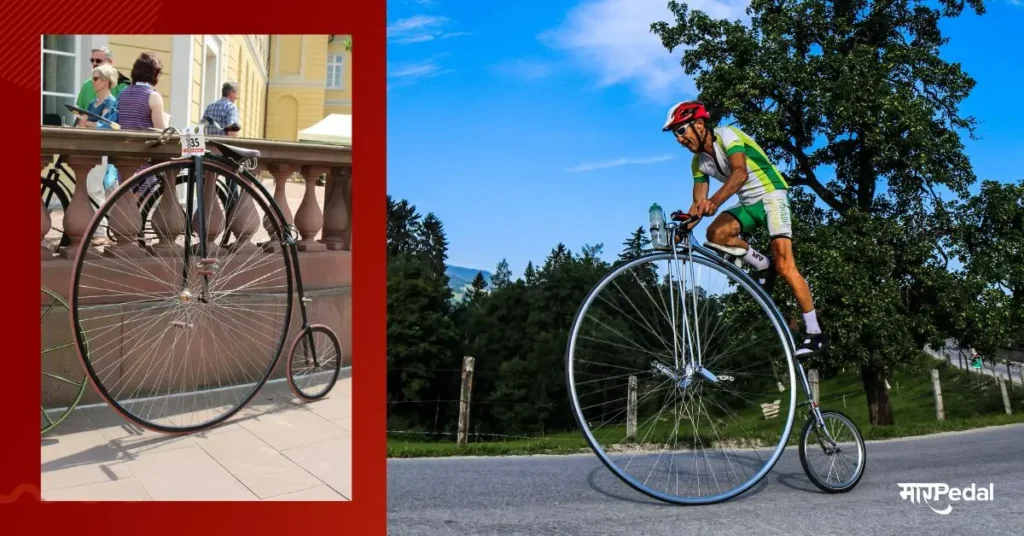
Have you ever seen an old photograph or painting of a man on a bicycle with a huge front wheel and a tiny back wheel?
That strange-looking bicycle is called a penny-farthing, and it was one of the earliest forms of bicycle, developed in the late 19th century.
While it may seem impractical and uncomfortable compared to modern bicycles, penny-farthing was a revolutionary invention that paved the way for future bicycle designs.
In this article, we’ll explore the unique features of penny-farthing and the impact it had on the history of cycling.
The Design of the Penny-Farthing
The penny-farthing got its name from the British penny and farthing coins, which were different in size just like the bicycle’s two wheels.
The front wheel was much larger than the back wheel, giving the bicycle a distinctive appearance. The size difference between the wheels was not just for aesthetics, though; it was a necessary design element that allowed the rider to achieve greater speeds.
The larger front wheel allowed for a greater distance to be covered with each rotation, making it possible to travel faster than on a bike with equally sized wheels.
The Risks of Riding a Penny-Farthing

However, the design of the penny-farthing also came with some serious risks. Because the front wheel was so much larger than the back wheel, the rider sat high in the air, several feet off the ground.
This made the bicycle very unstable and prone to accidents, especially when going downhill or turning. In the event of a fall, the rider would be thrown forward and could suffer serious injuries, including broken bones and head trauma.
The Riding Experience of the Penny-Farthing
Despite the dangers, many people enjoyed riding penny-farthings. The seating position allowed for a clear view of the road ahead, and the feeling of speed and freedom was exhilarating.
The lack of brakes or gears meant that riders had to rely solely on their own strength and skill to control the bicycle, which required a significant amount of physical fitness and coordination.
Riding a penny-farthing was not just a means of transportation, but also a form of recreation and sport.
The Impact of the Penny-Farthing
The penny farthing was a significant invention in the history of cycling. It was the first bicycle to use a chain-driven rear wheel, which allowed for greater efficiency and speed.
It also popularized the idea of using a bicycle for transportation, rather than just recreation. Messengers, delivery drivers, and other professionals who needed to travel quickly and effectively frequently used penny-farthing.
The bicycle became a symbol of progress and modernity, and its popularity helped fuel the growth of the cycling industry.
The Evolution of the Bicycle
As with any technology, newer and improved designs eventually replaced the penny-farthing.
The safety bicycle, which had equally sized wheels and a lower center of gravity, was developed in the late 1800s and quickly became the preferred type of bicycle for both transportation and recreation.
The safety bicycle was much easier and safer to ride than the penny-farthing, and it paved the way for the modern bicycles we know today.
What Was Unusual About the Penny-Farthing Bicycle?

The penny-farthing bicycle was a unique and unusual invention that revolutionized the world of transportation and cycling. Here are some of the most unusual facts about this iconic bicycle:
- The size of the wheels:
One of the most striking features of the penny-farthing bicycle was the huge front wheel, which could be up to five feet in diameter. This was necessary to achieve greater speed and efficiency, but it also made the bicycle very unstable and difficult to ride.
- The height of the bicycle:
The penny-farthing was also known for its tall frame, which made it difficult for shorter riders to mount and dismount. This, combined with the large front wheel, made the bicycle a challenge to ride for all but the most skilled and experienced cyclists.
- The lack of brakes:
Another unusual feature of the penny-farthing was the absence of brakes. Instead, riders had to rely on a technique called “backpedaling,” which involved slowing down the rear wheel by pedaling backward. This made the bicycle even more dangerous, especially when going downhill.
- The popularity among the upper class:
Despite its challenging design, the penny-farthing was a popular status symbol among the upper class, who saw it as a symbol of wealth, power, and leisure. This helped cement its place in history and contributed to its lasting legacy as an iconic form of transportation.
Overall, the penny-farthing bicycle was a truly unique and unusual invention that captured the imagination of people all around the world. While it may have been challenging and even dangerous to ride, it also paved the way for new innovations and advancements in the world of cycling.
How Do You Get on a Penny Farthing Bike?
Getting onto a penny-farthing bicycle is no easy feat. Due to its tall frame and large front wheel, it requires a specific technique to mount and dismount safely. Here’s a step-by-step guide to getting onto a penny-farthing:
- Stand next to the bicycle on the left-hand side.
- Hold onto the handlebars with your right hand and the saddle with your left hand.
- Place your left foot onto the pedal at the bottom of the bicycle’s frame.
- Use your right foot to kick off the ground and push the bicycle forward.
- As you start to move forward, swing your right leg over the frame and onto the saddle.
- Once you’re seated on the saddle, reach up and grab onto the handlebars with both hands.
- Begin pedaling the bicycle by pushing down on the pedals with your feet.
To dismount a penny-farthing, you’ll need to reverse these steps. It’s important to keep your weight centered over the bicycle and to use your feet and hands to control your movements at all times. It’s also a good idea to practice mounting and dismounting on a flat surface before attempting to ride a penny-farthing in more challenging conditions.
Getting onto a penny-farthing bicycle requires a specific technique and a bit of practice. However, with patience and persistence, you can master the art of mounting and dismounting and enjoy the thrill of riding one of history’s most iconic forms of transportation.
How to Ride a Penny Farthing?
Riding a penny-farthing bicycle is a unique and challenging experience that requires skill, balance, and confidence. Here are some tips for riding a penny-farthing:
- Get comfortable with the bicycle:
Before attempting to ride a penny-farthing, it’s important to spend some time getting comfortable with the bicycle. Practice mounting and dismounting, and take some time to get a feel for the handlebars, pedals, and saddle.
- Start off slowly:
When you’re ready to ride, start off slowly and focus on maintaining your balance. Keep your weight centered over the bicycle, and use your feet and hands to control your movements.
- Use your body to steer:
Unlike modern bicycles, penny-farthings don’t have handlebar brakes. Instead, you’ll need to use your body to steer the bicycle. Lean to the left or right to change direction, and use your feet to control your speed.
- Master the art of cornering:
Cornering on a penny-farthing can be tricky, especially at higher speeds. To corner effectively, lean into the turn and use your feet to pedal in the direction you want to go.
- Practice, practice, practice:
Riding a penny-farthing is a skill that takes time and practice to master. Start off on flat terrain and work your way up to more challenging conditions. With time and dedication, you’ll be able to ride a penny-farthing like a pro.
Riding a penny-farthing requires skill, balance, and confidence. By getting comfortable with the bicycle, starting off slowly, using your body to steer, mastering the art of cornering, and practicing regularly, you can enjoy the unique thrill of riding one of history’s most iconic forms of transportation.
Conclusion
The penny-farthing bicycle may seem like a strange relic from the past, but it played an important role in the development of cycling technology. Its unique design allowed for greater speed and efficiency but also came with significant risks.
The popularity of penny-farthing helped establish the bicycle as a practical and desirable form of transportation, and its legacy can still be seen in the bicycles we ride today.
FAQ
What is an interesting fact about the penny-farthing?
One interesting fact about penny-farthing is that it was the first bicycle to have a chain drive, which allowed riders to achieve greater speed and efficiency than ever before.
What is the penny-farthing bicycle used for?
The penny-farthing was primarily used for transportation and recreation during the late 1800s before it was eventually replaced by more practical and user-friendly bicycles.
What are some facts about the first penny-farthing?
James Starley, a British engineer, invented the first penny-farthing in 1871. It had a large front wheel and a small rear wheel and was made entirely of metal.
Why is a penny-farthing bicycle called a penny-farthing?
The penny-farthing bicycle is called that because of the large difference in size between the front and rear wheels, which resembles the difference in size between the two coins: a penny and a farthing.
What are the features of the penny-farthing?
The penny-farthing was known for its large front wheel, which could reach up to 5 feet in diameter, and its small rear wheel, which was used mainly for balance. It also had a high saddle, a curved handlebar, and no brakes.






